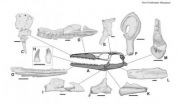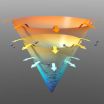(Press-News.org)
A new mosasaur species discovered in Hungary is the first known example of this group of scaled reptiles to have lived in freshwater river environments similar to modern freshwater dolphins, according to research published December 19 in the open-access journal PLOS ONE by Laszlo Makadi from the Hungarian Natural History Museum, Hungary and colleagues from the University of Alberta, Canada and MTA-ELTE Lendület Dinosaur Research Group, Hungary.
The species lived about 84 million years ago, the largest specimens reached about 20 feet in length, and belongs to a family called ‘mosasaurs’, conventionally thought of as gigantic finned marine lizards, similar and perhaps even related to present day monitor lizards. The researchers discovered several fossils of the new species, ranging from small juveniles to large adults that suggest that this species had limbs like a terrestrial lizard, a flattened, crocodile-like skull, and a tail unlike other known members of the mosasaur family.
The fossils were recovered from an open-pit mine in the Bakony Hills of Western Hungary, which were once flood-plains. According to the study, this is the first known mosasaur that lived in freshwater, and only the second specimen of a mosasaur to have been found in rocks that were not once deposited in the ocean. Makadi says, "The evidence we provide here makes it clear that similar to some lineages of cetaceans, mosasaurs quickly adapted to a variety of aquatic environments, with some groups re- invading available niches in freshwater habitats. The size of Pannoniasaurus makes it the largest known predator in the waters of this paleo-environment."
Even in the modern world, scaly reptiles in the aquatic world are extremely rare. Only a few species live in the water, and even fewer, like marine iguanas and sea kraits, live in the oceans. The new species described here probably adapted to freshwater environments similarly to river dolphins, such as those now inhabiting the Amazon, Ganges and Yangtze rivers.
INFORMATION:
Citation: Makadi L, Caldwell MW, Osi A (2012) The First Freshwater Mosasauroid (Upper Cretaceous, Hungary) and a New Clade of Basal Mosasauroids. PLoS ONE 7(12): e51781. doi:10.1371/journal.pone.0051781
Financial Disclosure: MWC was supported by an NSERC Discovery Grant (#238458-01) and a University of Alberta, Chairs Research Allowance. Fieldwork and the work of LM and AO were supported by the OTKA T-39045, PD-73021, NF-84193 grants; the MTA-ELTE Lendu let (Dinosaur Research Group, grant n.95102); the National Geographic Society; the Jurassic Foundation, and the Hantken Foundation. The funders had no role in study design, data collection and analysis, decision to publish, or preparation of the manuscript.
Competing Interest Statement: The authors have declared that no competing interests exist.
PLOS I OPEN FOR DISCOVERY
Jyoti Madhusoodanan | Press Manager, PLOS ONE
1160 Battery Street, Suite 100, San Francisco, CA 94111
jmadhusoodanan@plos.org I Main +1 415-568-4545 ext 187 I Fax +1 415-546-4090
plos.org I Facebook I Twitter I Blog
First freshwater mosasaur discovered
New species of 20-foot-long lizards lived in fresh water, similar to present-day river dolphins
2012-12-20
ELSE PRESS RELEASES FROM THIS DATE:
Transplanted neural stem cells treat ALS in mouse model
2012-12-20
LA JOLLA, Calif., December 19, 2012 – Amyotrophic lateral sclerosis (ALS), also known as Lou Gehrig's disease, is untreatable and fatal. Nerve cells in the spinal cord die, eventually taking away a person's ability to move or even breathe. A consortium of ALS researchers at multiple institutions, including Sanford-Burnham Medical Research Institute, Brigham and Women's Hospital, and the University of Massachusetts Medical School, tested transplanted neural stem cells as a treatment for the disease. In 11 independent studies, they found that transplanting neural stem cells ...
Unraveling the threads: Simplest cotton genome offers clues for fiber improvements
2012-12-20
From the stockings decorating mantles to the new outfits in display windows calling to shoppers, cotton is woven into the fabric of the holiday season. For bioenergy researchers, however, fiber composition matters more than color and texture as each cotton strand is composed of more than two dozen coils of cellulose, a target biomass for next-generation biofuels.
In the December 20, 2012 edition of Nature, an international consortium of researchers from 31 institutions including a team from the U.S. Department of Energy Joint Genome Institute (DOE JGI) present a high-quality ...
Occasional family meals enough to boost kids' fruit and veg intake
2012-12-20
Eating meals together as a family, even if only once or twice a week, increases children's daily fruit and vegetable intake to near the recommended 5 A Day, according to researchers at the University of Leeds.
The study of primary school-aged children, funded by the National Institute for Health Research Public Health Research (NIHR PHR) Programme, also suggests parental consumption of fruit and vegetables and cutting up portions of these foods boosted children's intake. It is published today in the British Medical Journal's Journal of Epidemiology & Community Health.
Overall, ...
Stars reveal the secrets of looking young
2012-12-20
Globular clusters are spherical collections of stars, tightly bound to each other by their mutual gravity. Relics of the early years of the Universe, with ages of typically 12-13 billion years (the Big Bang took place 13.7 billion years ago), there are roughly 150 globular clusters in the Milky Way and they contain many of our galaxy's oldest stars.
But while the stars are old and the clusters formed in the distant past, astronomers using the MPG/ESO 2.2-metre telescope and the NASA/ESA Hubble Space Telescope have found that some of these clusters are still young at heart. ...
How to look young when you're not
2012-12-20
Globular clusters are spherical collections of stars, tightly bound to each other by their mutual gravity. Relics of the early years of the Universe, with ages of typically 12-13 billion years (the Big Bang took place 13.7 billion years ago), there are roughly 150 globular clusters in the Milky Way and they contain many of our galaxy's oldest stars.
But while the stars are old and the clusters formed in the distant past, astronomers using the NASA/ESA Hubble Space Telescope and the MPG/ESO 2.2-metre telescope at the ESO La Silla Observatory have found that some of these ...
JILA physicists achieve elusive 'evaporative cooling' of molecules
2012-12-20
Achieving a goal considered nearly impossible, JILA physicists have chilled a gas of molecules to very low temperatures by adapting the familiar process by which a hot cup of coffee cools.
Evaporative cooling has long been used to cool atoms, at JILA and elsewhere, to extraordinarily low temperatures. The process was used at JILA in 1995 to create a then-new state of matter, the Bose-Einstein condensate (BEC) of rubidium atoms. The latest demonstration, reported in the Dec. 20, 2012, issue of Nature,* marks the first time evaporative cooling has been achieved with molecules—two ...
Scientists develop technique to help prevent inherited disorders in humans
2012-12-20
NEW YORK, NY (December 19, 2012) – A joint team of scientists from The New York Stem Cell Foundation (NYSCF) Laboratory and Columbia University Medical Center (CUMC) has developed a technique that may prevent the inheritance of mitochondrial diseases in children. The study is published online today in Nature.
Dieter Egli, PhD, and Daniel Paull, PhD, of the NYSCF Laboratory with Mark Sauer, MD, and Michio Hirano, MD, of CUMC demonstrated how the nucleus of a cell can be successfully
transferred between human egg cells. This landmark achievement carries significant implications ...
Scientists establish link between inflammatory process and progression of Alzheimer's disease
2012-12-20
WORCESTER, MA — An international team of researchers from the University of Massachusetts Medical School, the University of Bonn and the Center for Advanced European Studies and Research in Germany have shown that a well-known immune and inflammatory process plays an important role in the pathology of Alzheimer's disease. This process, which results in the mature production of the pro-inflammatory cytokine called interleukin-1 beta (IL-1B) and is involved in the body's defense against infection, has also been established as a clinical target for rheumatoid arthritis. The ...
NYSCF and CUMC scientists develop scientific technique to help prevent inherited disorders in humans
2012-12-20
NEW YORK, NY (December 19, 2012) – A joint team of scientists from The New York Stem Cell Foundation (NYSCF) Laboratory and Columbia University Medical Center (CUMC) has developed a technique that may prevent the inheritance of mitochondrial diseases in children. The study is published online today in Nature.
Dieter Egli, PhD, and Daniel Paull, PhD, of the NYSCF Laboratory with Mark Sauer, MD, and Michio Hirano, MD, of CUMC demonstrated how the nucleus of a cell can be successfully transferred between human egg cells. This landmark achievement carries significant implications ...
Asthmatics at increased risk of pulmonary embolism
2012-12-20
People with asthma have an increased risk of pulmonary embolism, according to new research.
A new study, published online ahead of print today (20 December 2012) in the European Respiratory Journal, looked at whether people with moderate or severe asthma had an increased risk of developing deep vein thrombosis, or pulmonary embolism.
Pulmonary embolism is when the main artery of the lung or the bronchi becomes blocked. It usually results from deep vein thrombosis; a blood clot in the veins, which can break off and move around the body to the lung.
Previous research ...
LAST 30 PRESS RELEASES:
Making lighter work of calculating fluid and heat flow
Normalizing blood sugar can halve heart attack risk
Lowering blood sugar cuts heart attack risk in people with prediabetes
Study links genetic variants to risk of blinding eye disease in premature infants
Non-opioid ‘pain sponge’ therapy halts cartilage degeneration and relieves chronic pain
AI can pick up cultural values by mimicking how kids learn
China’s ecological redlines offer fast track to 30 x 30 global conservation goal
Invisible indoor threats: emerging household contaminants and their growing risks to human health
Adding antibody treatment to chemo boosts outcomes for children with rare cancer
Germline pathogenic variants among women without a history of breast cancer
Tanning beds triple melanoma risk, potentially causing broad DNA damage
Unique bond identified as key to viral infection speed
Indoor tanning makes youthful skin much older on a genetic level
Mouse model sheds new light on the causes and potential solutions to human GI problems linked to muscular dystrophy
The Journal of Nuclear Medicine ahead-of-print tip sheet: December 12, 2025
Smarter tools for peering into the microscopic world
Applications open for funding to conduct research in the Kinsey Institute archives
Global measure underestimates the severity of food insecurity
Child survivors of critical illness are missing out on timely follow up care
Risk-based vs annual breast cancer screening / the WISDOM randomized clinical trial
University of Toronto launches Electric Vehicle Innovation Ontario to accelerate advanced EV technologies and build Canada’s innovation advantage
Early relapse predicts poor outcomes in aggressive blood cancer
American College of Lifestyle Medicine applauds two CMS models aligned with lifestyle medicine practice and reimbursement
Clinical trial finds cannabis use not a barrier to quitting nicotine vaping
Supplemental nutrition assistance program policies and food insecurity
Switching immune cells to “night mode” could limit damage after a heart attack, study suggests
URI-based Global RIghts Project report spotlights continued troubling trends in worldwide inhumane treatment
Neutrophils are less aggressive at night, explaining why nighttime heart attacks cause less damage than daytime events
Menopausal hormone therapy may not pose breast cancer risk for women with BRCA mutations
Mobile health tool may improve quality of life for adolescent and young adult breast cancer survivors
[Press-News.org] First freshwater mosasaur discoveredNew species of 20-foot-long lizards lived in fresh water, similar to present-day river dolphins




